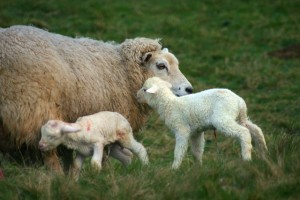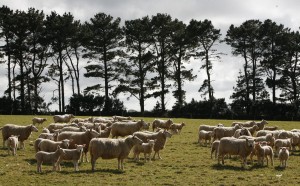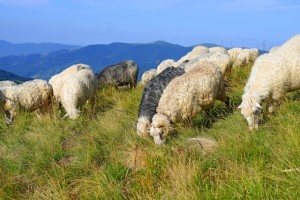Understanding Behavior
Knowledge of animals’ natural behavior is essential in ensuring we create an environment and manage and care for individual animals and flocks in a manner that enables them to express themselves naturally and to remain healthy with a high quality of life. The behavior of sheep is likely to be a complex interaction between their genetics and the fundamentally important early life experiences with their dam, further complicated by their association with their peers, particularly around weaning, and the quality and availability of grazing (Lawrence and Dwyer, 2000).
Maternal Behavior
Maternal behavior is key to ensuring survival of lambs, particularly when a ewe has two or more offspring. Newborn lambs need milk and immunological protection shortly after birth, and early interactions between the mother and the young are critical in this respect. Bonding, and consequently survival, of twins can be considerably improved if the ewe remains at the birth site for a minimum of 6 hours, and this can be encouraged in part through feeding management. Two major factors contribute to the formation of this early bonding: postnatal vocal communication and sucking (Nowak, 1996).

The ewe makes a low level bleating noise, standing so as to encourage the lamb to find the udder and start suckling (Dwyer, 2013)
Research at the Scotland’s Rural College has shown that:
- lambs that are quick to stand and suck after birth have better survival than lambs that are slow to get up and suck.
- lamb behaviors are influenced by lamb genetics – breed, selection line within breed and sire of the lamb all affected early lamb behaviors. Lamb behavior immediately after birth is heritable, suggesting that selection for lamb behavioral traits could improve lamb vigour at birth and increase lamb survival.
- lamb rectal temperatures are correlated with lamb behavior. Taking a lambs temperature soon after birth could provide useful information on lamb vigour.
The ewe and lamb maintain a close spatial relationship over the first week of life. After this period lambs gather into peer play groups and up to 4 weeks of age they go increasingly longer distance from their dam (Morgan & Arnold, 1974). Nurturing and recognition are the key components of early maternal care, and the ewe expresses these through immediate licking and grooming behavior, which enables her to learn the smell of her offspring (Poindron et al., 2007).
What About Breed and Behavior?
In addition to recognizing their mothers’ voice, lambs also visually recognize breeds (Lawrence and Dwyer, 2000) and are attracted by the sight of the same breed in the absence of their mother (Walser, 1980). There are significant breed differences in grazing, activity and social interactions. Maternal influence plays an important role in shaping the behavior of offspring as they develop. This is not evident immediately after birth, however, as breed differences are most evident with regard to sucking and early vigour and play behavior.
Social grouping, associations and activity patterns in sheep are influenced by breed although it is not clear whether these are entirely genetic differences or differences associated with learning and adaptation resulting from different environmental and social experiences, especially during early life (Lawrence and Dwyer, 2000).
Sheep can discriminate between breeds and there is evidence of strong preferential mixing between sheep of the same breed (Winfield and Mullaney, 1973; Arnold and Pahl, 1974; Walser and Hague, 1980).
Recording Birth Behavior
Genetic solutions have the potential to improve birth assistance and lamb behavior but require large amounts of data. Simple, proxy methods (scoring systems) have been developed to quantify the level of birth difficulties and lamb vigor on farm. Analysis of simple birth assistance scores shows abnormal birth positions require more assistance than normal births and long births need more assistance than short labors. Likewise, evaluating a lamb vigor score showed more vigorous lambs reach key behavioral stages faster than those with low vigor and a sucking assistance score was successful in demonstrating that lambs that were slow to start sucking needed the most assistance. A 5-point behavior scoring system that records time from birth to standing, seeking the udder and sucking has provided a practical and reliable assessment of birth assistance and lamb behavior (Matheson et al., 2011).
Eating Habits
Social learning influences dietary habits, with lambs generally acquiring a preference for foods or grazing behaviors that they have learned about from their mothers or from young companions (Stolba et al., 1990; Lawrence, 1990; Lawrence and Wood-Gush, 1988). They also have a preference for feeds that are nutritious and avoid those that are toxic, again following early positive or negative experiences (Scott et al., 1995).
The location of preferred foods will influence where sheep choose to forage. As they grow, lambs will imitate the mother’s preferences for grazing location (Lawrence and Dwyer, 2000). It has been proposed that exposing social groups of sheep to underutilized habitat types early in life may increase their usage of these areas at later stages and therefore careful and strategic grazing management can offer the best opportunity to improve grazing distribution (Scott et al., 1995).
There is more information on the grazing behavior of sheep in the section on Extensive Grazing.
Linking Behavior to Management
“An improved understanding of the biological basis for the onset of maternal behavior, and thus an appreciation of which events and critical time windows are most important for the ewe, will aid the development of appropriate management to facilitate the ability of the ewe to express these behaviors“.
“Management practices that work with the biology of the ewe will be the most successful in ensuring that maternal care is expressed, so improving the welfare of the ewe and lamb, and the profitability of the farm” (Dwyer, 2013).
For further information on behavior visit the pages on
Sheep Housing and Handling
and


 British English
British English



Comments are closed.